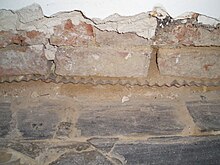Chrome steel sheet process
Chrome steel sheet process is a term from the construction industry.
The chrome steel sheet process is a process for the subsequent sealing of masonry walls against rising damp . It was developed by Haböck and Weinzierl in 1975 and is therefore also called the HW process .
With the chrome steel sheet process, corrugated sheets are rammed into a horizontal joint in the masonry with an overlap, thus preventing any further penetration of moisture into the masonry. The chrome steel sheet process has the advantage that the separation and sealing can be carried out in one operation without opening the wall. The pointed stainless steel plates are hit with pneumatic hammers with a dead weight of 20 kg to 40 kg and an impact frequency of 1100 to 1450 blows / min. driven through the wall joint or through the brick without interrupting the flow of force in the wall.
Settling the wall and the formation of settlement cracks is not possible as the mortar band is compressed by 10–20% when the slabs are hammered in. The chrome steel sheet process has been in use for around 30 years and has proven itself well. The fears often expressed at the beginning about the stability of the buildings have not been confirmed.
